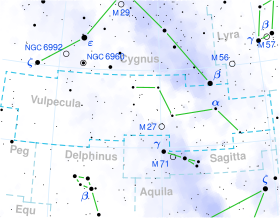12 Vulpeculae
| Observation data Epoch J2000 Equinox J2000 | |
|---|---|
| Constellation | Vulpecula |
| Right ascension | 19h 51m 04.1083s[1] |
| Declination | +22° 36′ 36.173″[1] |
| Apparent magnitude (V) | 4.928±0.015[2] (4.78 - 4.97)[3] |
| Characteristics | |
| Spectral type | B2.5V[4] |
| Apparent magnitude (U) | 4.104±0.020[2] |
| Apparent magnitude (B) | 4.759±0.017[2] |
| Variable type | Be star[3] |
| Astrometry | |
| Radial velocity (Rv) | −24.90[5] km/s |
| Proper motion (μ) | RA: 23.404±0.068[1] mas/yr Dec.: −15.797±0.099[1] mas/yr |
| Parallax (π) | 5.1710 ± 0.1070 mas[1] |
| Distance | 630 ± 10 ly (193 ± 4 pc) |
| Absolute magnitude (MV) | −1.52[4] |
| Details | |
| Mass | 6.8[6] M☉ |
| Luminosity | 963[4] L☉ |
| Surface gravity (log g) | 3.36[7] cgs |
| Temperature | 18,859[7] K |
| Metallicity [Fe/H] | −0.01[7] dex |
| Rotational velocity (v sin i) | 195[8] km/s |
| Other designations | |
| Database references | |
| SIMBAD | data |
12 Vulpeculae is a star in the northern constellation of Vulpecula, located approximately 630 light years away based on parallax.[1] It has the variable star designation V395 Vul; 12 Vulpeculae is the Flamsteed designation. This object is visible to the naked eye as a faint, blue-white hued star with a baseline apparent visual magnitude of 4.928.[2] It is moving closer to the Earth with a heliocentric radial velocity of -25 km/s.[5]
This is a variable Be star with a stellar classification of B2.5V;[4] its brightness ranges from magnitude 4.78 down to 4.97.[3] As is true with other Be stars, it has a high rate of rotation with a projected rotational velocity of 195 km/s.[8] The star has 6.8[6] times the mass of the Sun and is radiating 963[4] times the Sun's luminosity from its photosphere at an effective temperature of 18,859 K.[7]
References
[edit]- ^ a b c d e f Brown, A. G. A.; et al. (Gaia collaboration) (2021). "Gaia Early Data Release 3: Summary of the contents and survey properties". Astronomy & Astrophysics. 649: A1. arXiv:2012.01533. Bibcode:2021A&A...649A...1G. doi:10.1051/0004-6361/202039657. S2CID 227254300. (Erratum: doi:10.1051/0004-6361/202039657e). Gaia EDR3 record for this source at VizieR.
- ^ a b c d Harmanec, P.; et al. (2020). "A new study of the spectroscopic binary 7 Vul with a Be star primary". Astronomy and Astrophysics. 639. Table A.1. arXiv:2005.11089. Bibcode:2020A&A...639A..32H. doi:10.1051/0004-6361/202037964. S2CID 218862853.
- ^ a b c Samus, N. N.; Durlevich, O. V.; et al. (2009). "VizieR Online Data Catalog: General Catalogue of Variable Stars (Samus+ 2007-2013)". VizieR On-line Data Catalog: B/GCVS. Originally Published in: 2009yCat....102025S. 1. Bibcode:2009yCat....102025S.
- ^ a b c d e Anderson, E.; Francis, Ch. (2012). "XHIP: An extended hipparcos compilation". Astronomy Letters. 38 (5): 331. arXiv:1108.4971. Bibcode:2012AstL...38..331A. doi:10.1134/S1063773712050015. S2CID 119257644. Vizier catalog entry
- ^ a b Gontcharov, G. A. (2006). "Pulkovo Compilation of Radial Velocities for 35 495 Hipparcos stars in a common system". Astronomy Letters. 32 (11): 759–771. arXiv:1606.08053. Bibcode:2006AstL...32..759G. doi:10.1134/S1063773706110065. S2CID 119231169.
- ^ a b Tetzlaff, N.; Neuhäuser, R.; Hohle, M. M. (2011). "A catalogue of young runaway Hipparcos stars within 3 kpc from the Sun". Monthly Notices of the Royal Astronomical Society. 410 (1): 190–200. arXiv:1007.4883. Bibcode:2011MNRAS.410..190T. doi:10.1111/j.1365-2966.2010.17434.x. S2CID 118629873. Vizier catalog entry
- ^ a b c d Wu, Yue; Singh, H. P.; Prugniel, P.; Gupta, R.; Koleva, M. (2010). "Coudé-feed stellar spectral library – atmospheric parameters". Astronomy & Astrophysics. 525: A71. arXiv:1009.1491. Bibcode:2011A&A...525A..71W. doi:10.1051/0004-6361/201015014. S2CID 53480665.
- ^ a b Abt, Helmut A.; Levato, Hugo; Grosso, Monica (2002). "Rotational Velocities of B Stars". The Astrophysical Journal. 573 (1): 359–365. Bibcode:2002ApJ...573..359A. doi:10.1086/340590.
- ^ "12 Vul". SIMBAD. Centre de données astronomiques de Strasbourg. Retrieved 2018-11-19.

